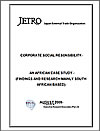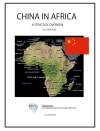 Ethiopian Telecommunication Corporation (ETC)
Ethiopian Telecommunication Corporation (ETC)
All data are collected in the Fiscal Year of 2008-2009.
Company Profile and History
The introduction of telecommunications services in Ethiopia dates back to 1894, when Minilik II, the King of Ethiopia, introduced telephone technology to the country. However the first Ethiopian pioneer of telephony was his cousin Ras Mekonnen who came back with telephone apparatus in 1889 after his visit of Italy and established a company. The company was placed under government control at the beginning of the twentieth century, and was later brought to operate under the auspices of the Ministry of Post and Communications. In 1952, telecommunications services were separated from the postal administration, and structured under the Ministry of Transport and Communications. The Ethiopian Telecommunications Corporation is the oldest Public Telecommunications Operator (PTO) in Africa.
Under the Dergue Regime the Ethiopian Telecommunications was reorganized as: Ethiopian Telecommunications Service from October 1975 to February 1981; and
Ethiopian Telecommunications Authority (ETA) on January 1981. It retained this name until November 1996. The Ethiopian Telecommunications Service as well as the Ethiopian Telecommunications Authority (ETA) was in charge of both the operation and regulation of telecommunications service in Ethiopia.
The Ethiopian Telecommunications Authority was replaced by the Ethiopian Telecommunications Corporation (ETC) by regulation number 10/1996 of the Council of Ministers to which all the rights and obligations of the former Ethiopian Telecommunication authority were transferred to the Corporation.
There are 966 public service stations and exchanges across the country. The number of rural kebeles - the lowest administrative unit - with telephone access increased from only 60 in 2004/05 to 8 676 in 2007/08, and the target is to provide access to telecom services to all 15 000 rural kebeles by 2010. By the end of 2007/08, the number of cellular telephone (mobile) subscribers increased nearly five times from the 2004/05 level, reaching 1 954 527; the number of broadband customers reached 1 496, up from only 65 in 2002/03; and the dial-up Internet subscribers were 34 110, almost twice the number in 2004/05. Teledensity, excluding mobile phones, has tripled since 2000/01 to reach 1.23 per 100 households in 2007/08. Including mobile phones, teledensity reached 3.88 in 2007/08 from only 0.48 in 2000/01.
In 2005, ETC installed a national fibre optic backbone comprising 4 000 kilometres radiating out in six major directions from the capital (to Dire Dawa, Djibouti, Dessie-Mekele, Bahir Dar-Nekemte, Jimma and Awassa), laying a foundation for delivering current and future services including digital radio, TV, Internet, data and other multimedia services. In order to increase the service capacity, reliability, quality, speed and size of data transfer, ETC transferred from narrowband to broadband service in January 2005. The introduction and installation of broadband Internet, broadband VSAT and broadband multimedia infrastructure are among the major achievements of the past 12 years. Currently there are 1 318 submarine gateway circuits that connect Ethiopia with the rest of the world.
In Country Location
Ethiopian Telecommunications: Corporation Head Quarter; Churchill Road, in front of Main Post Office Building; Tel: +251-115-510500; Fax: +251-115-515777
Services and Products
ETC provides fixed line telephony, mobile telephone and Internet and multimedia services. ETC uses satellites, digital radio multi access system (DRMAS), Very Small Aperture Terminal (VSAT), Ultra High Frequency (UHF), Very High Frequency (VHF), long line and high frequency (HF) radio networks.
ETC provides different types of Internet services including dial up, leased line and shared DSL Internet services to government organisations, private and commercial companies, international institutions and individuals. The broadband Internet services uses asymmetric digital subscriber line (ADLS) and fixed wireless access (FWA) technologies. Some of the uses of VSAT in Ethiopia includes
- School Net services (providing high schools with standard educational programmes through television);
- Woreda Net services (connecting the woreda centres of the country - the administrative unit higher than kebele - with the federal government and with each other using Internet, data, video conferencing and voice services;
- Agri Net services (for connection of agricultural institutions with the federal government and with each other)
- Health Net (for the provision of a wide range of information services that are crucial to health care by connecting healthcare professionals throughout the country.
Ethiopia has signed dual international roaming agreements with 144 countries in order to increase its international roaming service. ETC has also started providing roaming services to foreigners coming from countries where the Corporation has made an international roaming agreement.
Number of Employees
12,288 employees
Financial Information
| Net income after tax | 2.4 billion Br. (2009) |
|---|---|
| Gross profit | 3.5 billion Br (2009) |
| Gross revenue | 5.7 billion Br (2009) |
Market Share
ETC a public telecom operator, has a monopoly over all telecom services
Business Objective
“Develop and maintain a modern information and communication network infrastructure capable of supporting voice, data and video services, equitably across the country and with high capacity digital connectivity to the rest of the world”
Business Model
“Our strategic plan:
- The network capacity of fixed telephone will be raised from 1,058 million to 4.4 million lines as well as the network capacity of mobile telephone and internet shall also be raised from 1.5 million and 100,000 to 9.9 million and 1,000,000 respectively
- In addition to the existing 4,000 Kms optic fibre, additional 10,000 Kms fibre cable shall also be installed for redundancy purpose and avoiding the possible prevalence of service interruption
- Fixed telephone density will grow to 4 percent mobile telephone density to 9.7 percent together with 85 percent of geographical coverage of mobile telephone radio wave. Similarly, all rural kebeles of the country shall have at least one telephone together will creating a fertile ground to enable these rural kebeles beneficiaries of internet technology
- During the implementation period of the strategic plan, internet density shall be raised from 0.02 to 0.23 and the number of internet subscribers will grow to 1,000,000
- Expanding a 2.5 million network capacity of Code Dibision Multiple Access Wireless Local Loop (CDMA-WLL) technology for both urban and rural parts of the country
- Expanding IP beared for effective utilization of data network
- Installation of 50,000 public telephones all over the country
- Establishing state-of-the art call centre
- Establishing modern customer care and billing system
- Establishing national network operation centre;
- Establishing prepaid service intelligent network.
At the end of the implementation period of the strategic plan:
- All woreda towns of the country shall become beneficiaries of digital telephone and broadband data services as well as with the raising of mobile telephone radio wave coverage that enable all rural kebeles of the country to be beneficiaries of mobile telephone service
- The distribution and coverage of mobile telephone shall reach all major roads of the country, town centres, tourist centres, historical places and industrial villages
- All Schools and woredas of the country shall be beneficiaries of modern information and communications technology through strengthening the woreda-net and school-net projects
- Upon the full realization of the aforementioned tasks, one among ten persons in the country will get access to telecom services at the end of the strategic plan
- Expanding 14,0000Km optical fibre transmission network and creating prompt and sustainable telecommunications as well as information and communication Technology Carbon infrastructure in order to accelerate the local and international telecom services
- Make all 15,000 rural kebeles of the county beneficiaries of telecom services using wireless technology coverage
In the year 2010, one person among ten people in Ethiopia is expected to get access to telephone services thereby making Ethiopia to leap into the information Age in the shortest possible time.”
ETC’s Growth Perspectives in network coverage
| Focal Area | Current Status |
Phase II (2007/8年) |
Phase II (2009年) |
Phase III (2010年) |
|---|---|---|---|---|
| Fixed | ||||
| Capacity(millions) | 1058 | 2 | 3 | 4.4 |
| Penetration | 1.2 | 2 | 2.95 % | 4.0% |
| Mobile | ||||
| Capacity(millions) | 1.5 | 6.54 | 7.5 | 9.9% |
| Penetration | 1.53 | 6.5 | 7.4% | 9.7% |
| Coverage | <20 % | 50% | 70% | 85 % |
| Fiber | 4000km | 7000km | 10000km | 14000km |
| Broadband(PoPs) | 16 | 40 | 200 | >500 |
| Dial up Internet User | 150,000 | 500,000 | 800,888 | 1,000,000 |
Ownership of Business
ETC is a whole owned state company
Benefits Offered and Relations with Government
The ETC finances the expansion of its telecommunication services through vendor financing schemes. In addition, mobile phone handsets are subject to taxation when they are imported but not taxed when sold in the domestic market. The tax rate levied on the value of mobile handsets is 36.82 percent, including custom duty (5 percent), value added tax (15 percent), withholding tax (3 percent) and surtax (10 percent). The black market for mobile phone handsets is a serious concern to ETC as the government loses the revenue that ought to be generated from the taxation of handsets. ETC charges for fixed line and mobile phone usage in addition to the 15 percent value-added tax.
Product Development
In 2009 ETC launched a pilot project for notifying post paid mobile phone subscribers of their bills through text messages; and it began providing ‘General Packet Radio Service’ (GPRS) that enables subscribers to receive as well as send text, visual, and audio-video massages from the Internet using GPRS Enabled Mobile Apparatus. The new technology enables subscribers to obtain e-mail service through their GPRS enabled mobile apparatus; however, access to GPRS is limited to post-paid mobile subscribers for the time being. The corporation envisages providing similar service to prepaid mobile subscribers in the future.
Nine projects of its Next Generation Networking (NGN) would be completed and ready for use by January 2010. These projects began in September 2008-09 with an outlay of 1.5 billion Br paid out of its own coffers. These projects include GSM mobile, CDMA-WLL, optical fibre transmission, and next generation call centres, which are at various levels of completion.




